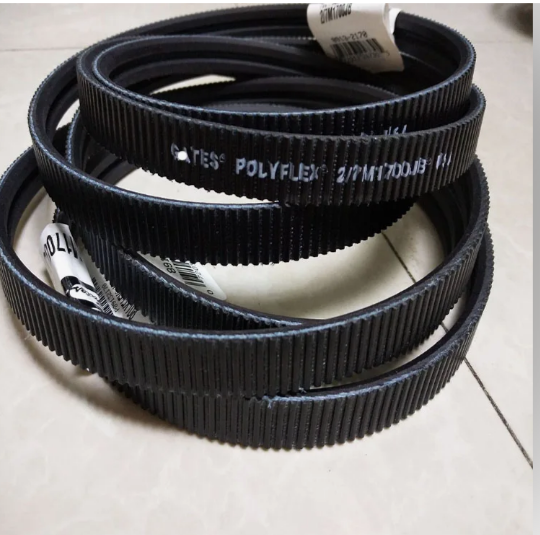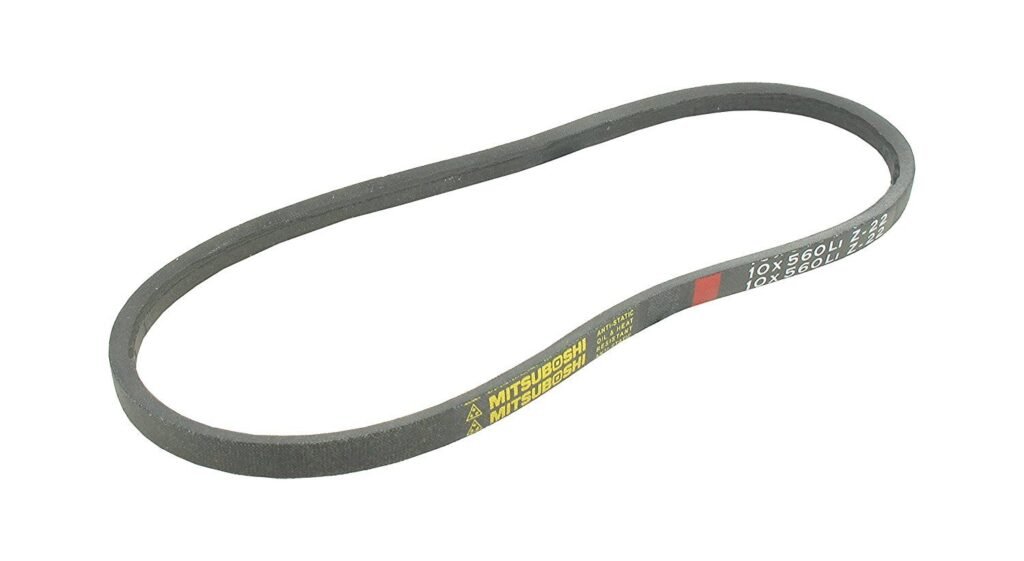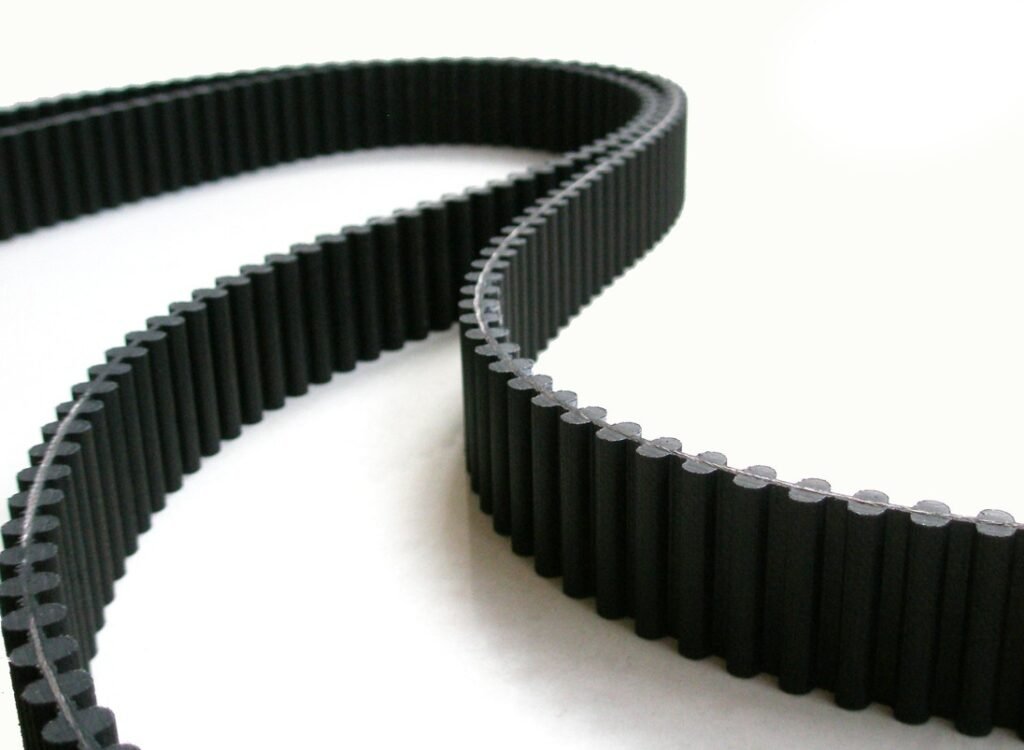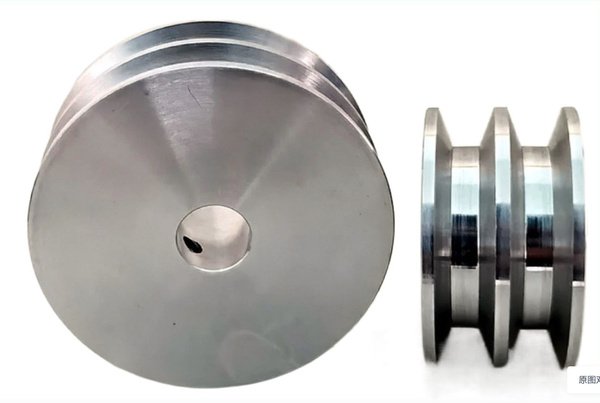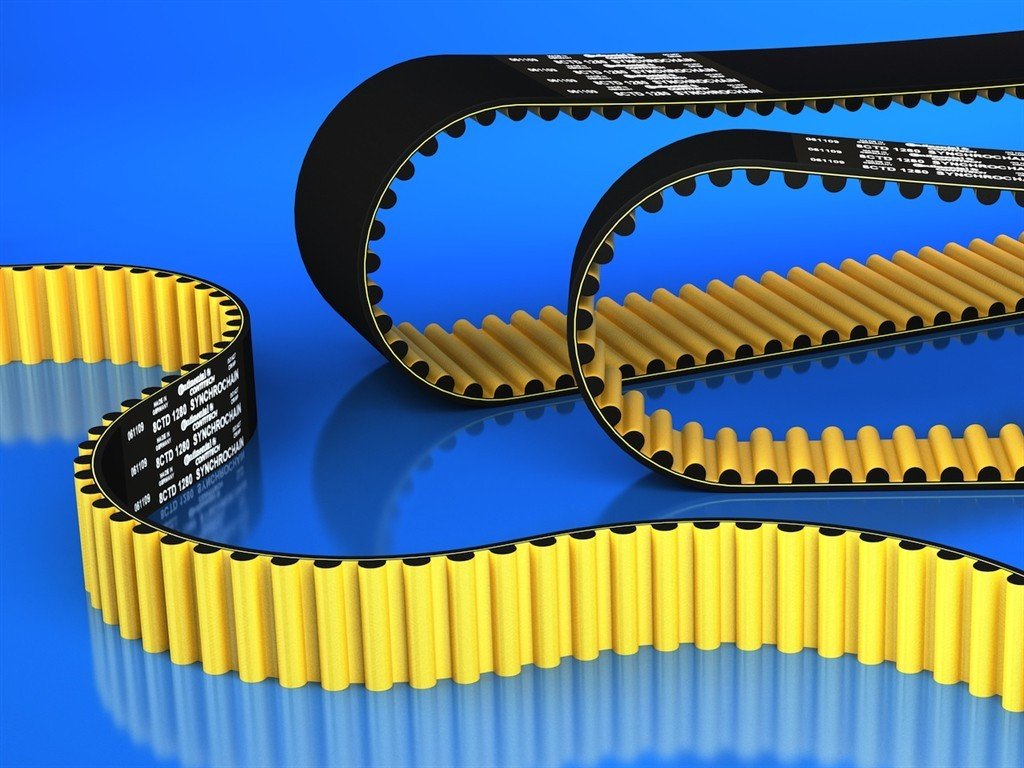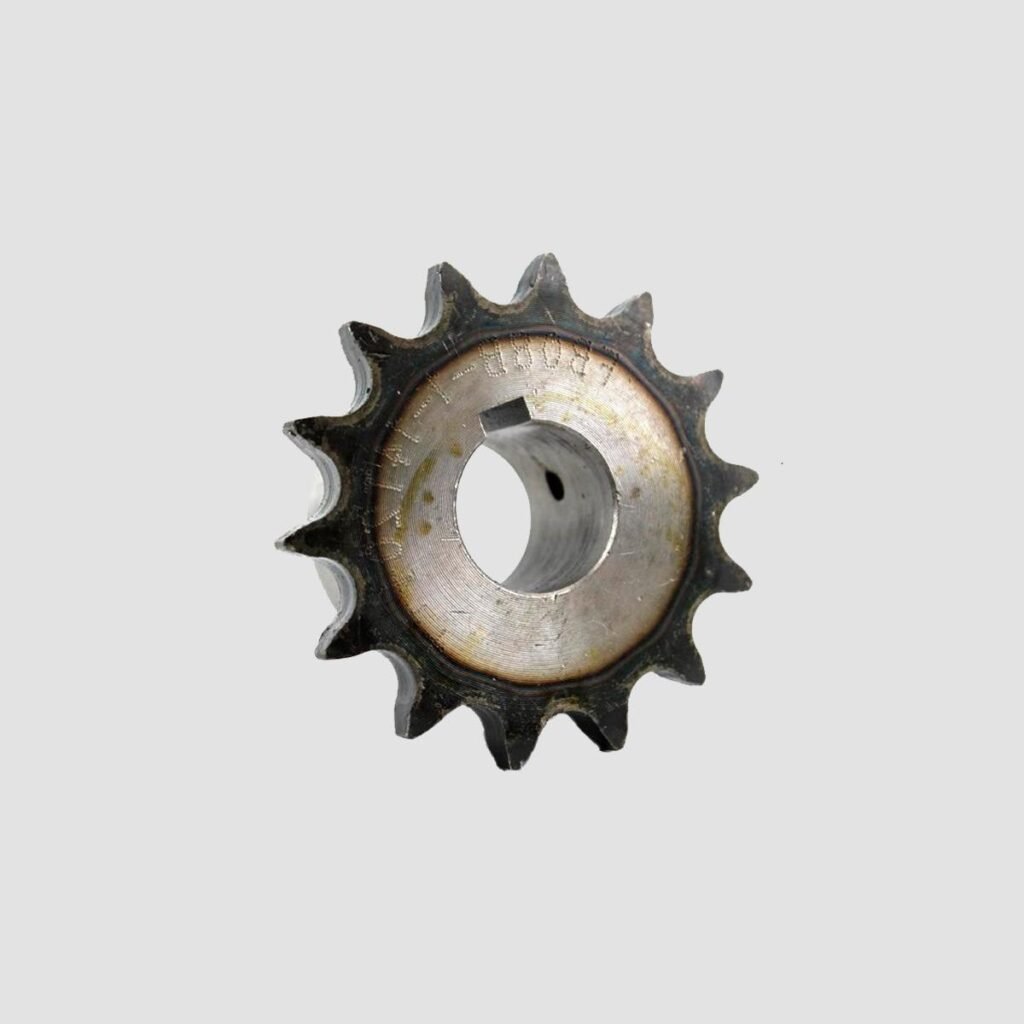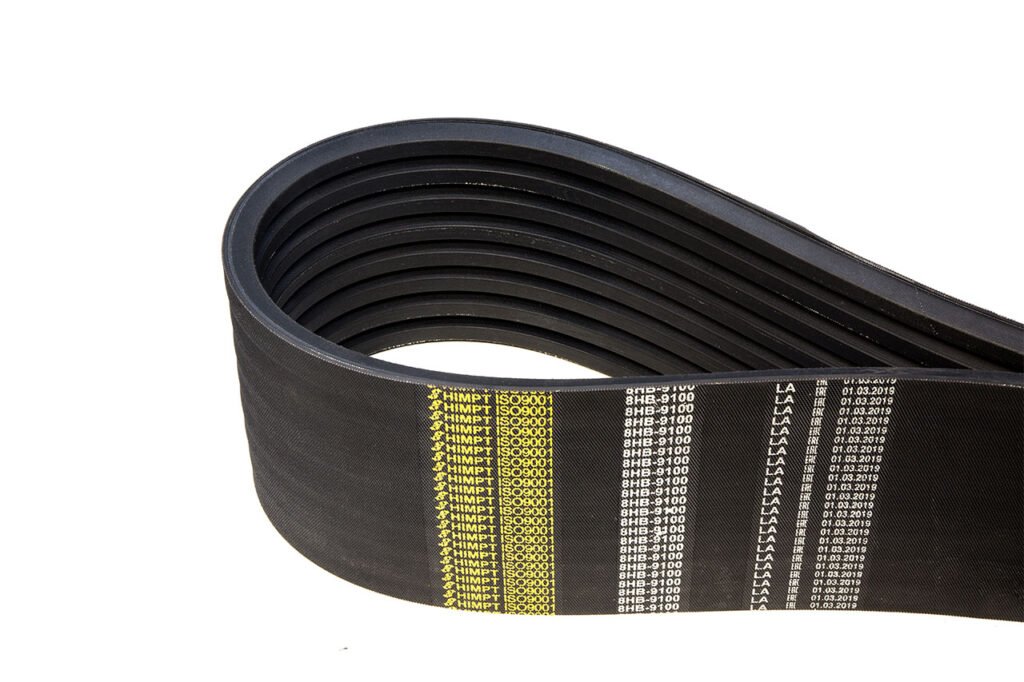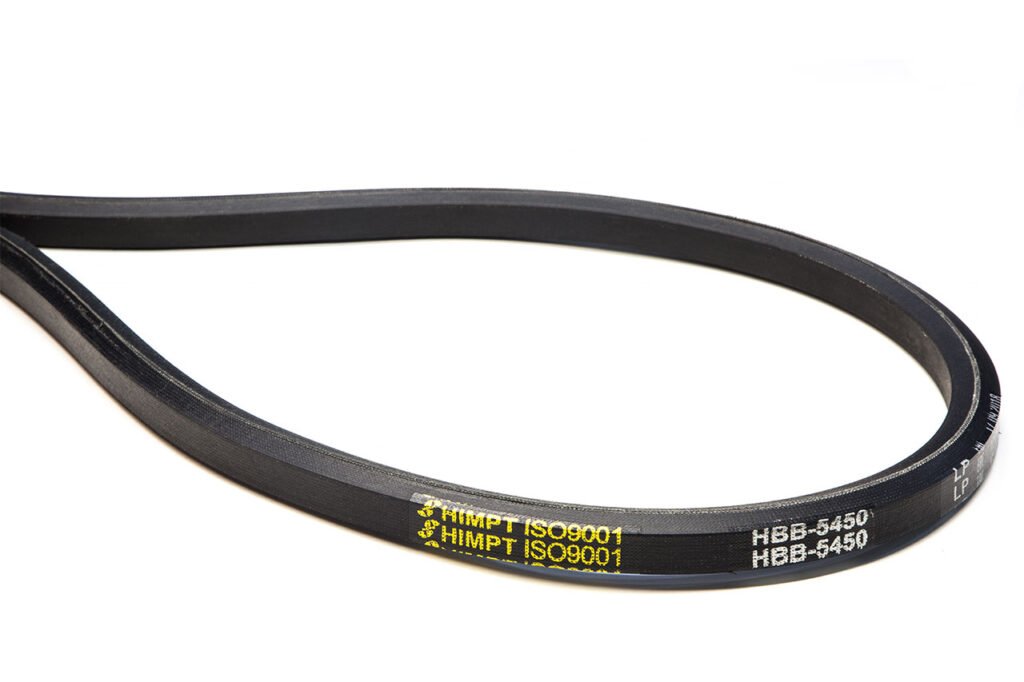Blog Sollosshop
SINGLE-TOOTHED BELT
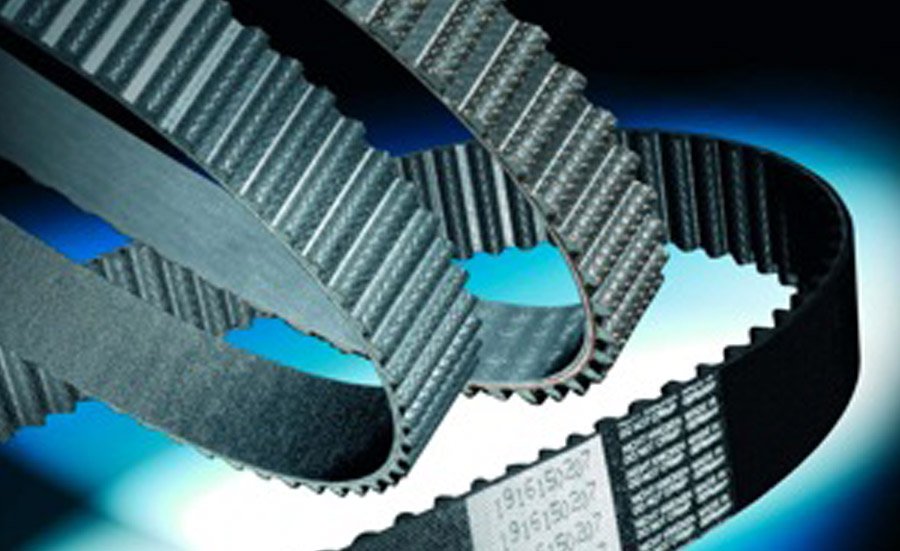
Everything you Need to Know about Single-tooth Belts
A single–toothed belt is a specialized type of belt that is used in various mechanical systems to transmit torque. These belts are used in a variety of industries, from automotive to industrial equipment. In this blog, we will look at the design, advantages and applications of single-tooth belts.
Design and Principle of Operation
A single-toothed belt, as a rule, consists of the following components:
-
The main material of the belt: Usually it is rubber or polyurethane, which have high strength and durability.
-
Reinforcing fibers: These fibers, most often made of fiberglass or Kevlar, give the belt additional strength and resistance to stretching.
-
Toothed surface: The teeth on the inside of the belt allow it to securely lock onto the toothed pulley, preventing slippage and ensuring accurate torque transmission.
The principle of operation of a single-toothed belt is that its teeth interlock with the teeth of the pulley, which allows you to transfer power from one component of the system to another with high efficiency.
Advantages Of Single-Tooth Belts
-
High power transmission efficiency: The gear clutch ensures minimal energy loss.
-
Precise synchronization: Such belts are ideal for systems that require synchronous movement, for example, in internal combustion engines.
-
Low noise: Due to the smooth engagement, single-toothed belts operate significantly quieter than chain gears.
-
Durability: The materials and construction used ensure a long service life even under high loads.
The Use Of Single-Toothed Belts
Single-tooth belts are used in a wide variety of fields, including:
-
Automotive industry: Here they are used in the drives of gas distribution mechanisms, where accuracy and reliability are extremely important.
-
Industrial equipment: In various machines and mechanisms for transmitting motion and power.
-
Household appliances: For example, in washing machines and dryers to control the movement of the drum.
-
Robotics: In drives and mechanisms where precise motion transmission is required.
Single-toothed belts are an important element in mechanical systems, providing efficient and reliable power transmission. Their design and advantages make them indispensable in a number of industries. Understanding their operation and application helps to optimize production processes and improve the performance of equipment.
If you have any questions about the choice or use of single-tooth belts, you can always contact specialists in this field to find the optimal solution for your tasks.
Choosing A Single-Toothed Belt
When choosing a single-tooth belt, it is important to consider several key factors to ensure its optimal performance in your system:
-
Belt Material: As mentioned earlier, belts can be made of various materials such as rubber, polyurethane and others. Rubber is usually more flexible and suitable for conditions with moderate loads, whereas polyurethane provides better resistance to wear and chemical influences.
-
Tooth type: The tooth profile of the belt must match the tooth profile of the pulley to ensure the best grip. Different types of profiles, such as trapezoidal or rounded, may be more suitable for certain applications.
-
Belt size: The width and length of the belt must meet the requirements of your equipment. Insufficient length can lead to tension and damage to the belt, while too long a belt can slip.
-
Load and speed: The belt must withstand the expected loads and speeds of rotation. Excessive load can lead to premature wear or rupture of the belt.
-
Operating conditions: The conditions in which the belt will operate (temperature, humidity, presence of chemicals) also play an important role. Some materials are more resistant to extreme conditions than others.
Maintenance and Care
Regular maintenance of single-tooth belts can significantly extend their service life and prevent unexpected breakdowns:
-
Tension check: Make sure that the belt is stretched correctly. Excessive tension can cause damage to the belt and pulleys, and insufficient tension can lead to slippage.
-
Wear inspection: Periodically check the belt for cracks, tooth wear and other damage. Replacing a worn belt in a timely manner will help to avoid more serious breakdowns.
-
Cleaning: Keep the belt and pulleys clean. The accumulation of dirt and dust can impair grip and accelerate belt wear.
-
Lubrication of pulleys: Some systems may require lubrication of the pulleys to ensure smooth movement and reduce wear.
Prospects and Innovations
Belt drive technology continues to evolve, offering new materials and designs that can improve the efficiency and durability of single-tooth belts. For example:
-
New materials: Research in the field of composite materials and nanotechnology can lead to the creation of belts with improved strength and wear resistance characteristics.
-
Improved tooth profiles: New tooth profiles can provide better grip and reduce noise.
-
Intelligent belts: In the future, belts with built-in sensors may appear to monitor the condition of the belt in real time, which will allow you to predict and prevent breakdowns before they occur.
Conclusion
Single-tooth belts play an important role in the modern world, providing efficient and reliable power transmission in a variety of mechanical systems. Understanding their design, advantages and the right choice can significantly improve the performance and reliability of your equipment.
With proper maintenance and use, these belts can serve for a long time and reliably, maintaining the operation of your equipment at a high level. Keep an eye on new developments and technologies in this area to always stay up to date with the latest achievements and opportunities to improve your system.
If you still have questions or would like to learn more about specific types of single-tooth belts, do not hesitate to contact experts and specialists who will help you make the right choice.
5 Features Of Single-Tooth Belts
-
Accurate Synchronization
Single-toothed belts ensure high synchronization accuracy between rotating components. Thanks to the toothed profile, the belt securely adheres to the teeth of the pulley, which minimizes slippage and ensures an accurate ratio of rotation speeds. This makes them ideal for systems where synchronicity is needed, for example, in internal combustion engines and robotics.
-
High Efficiency Of Power Transmission
Due to minimal slippage and deformation losses, single-tooth belts ensure high power transmission efficiency. This means that more energy is transferred from the drive mechanism to the slave, which is especially important in industrial and automotive applications where maximum performance is required.
-
Low Noise and Vibration
Single-toothed belts work much quieter compared to chain gears. Their design ensures smooth engagement of the teeth, which reduces noise and vibration. This makes them suitable for use in household appliances and other applications where noise levels matter.
-
Durability and Reliability
The materials used, such as reinforced rubber or polyurethane, in combination with reinforcing fibers, provide single-tooth belts with high strength and resistance to wear. They are able to withstand significant loads and work in difficult operating conditions, which guarantees a long service life and reliability in operation.
-
Easy Maintenance and Replacement
Single-tooth belts are relatively easy to install and require minimal maintenance. Regular checks and maintaining the correct tension can significantly extend the service life of the belt. In case of wear or damage, the belt is easily replaced, which reduces equipment downtime and maintenance costs.
These five features make single-tooth belts indispensable in various industries and applications. Their high accuracy, efficiency, low noise, durability and ease of maintenance ensure reliable operation and optimal equipment performance. Understanding these features helps you choose the right belt for specific tasks and operating conditions.
Ordering A Single-Toothed Belt
If you need a high-quality single-tooth belt, you can easily and conveniently order it online. The SollosShop store offers a wide range of belts at a bargain price. You can place an order in the following ways:
-
Buy a single-tooth belt at: SollosShop.com
-
Single-tooth belt Delivery: SollosShop.com
-
Order a single-toothed belt at: SollosShop.com
-
How to choose a single-toothed belt: SollosShop.com
-
Online ordering of a single-toothed belt for: SollosShop.com
Contact information
Website: www.sollosshop.com
E-mail: Shop@sollosshop.com
WhatsApp, Telegram: +48 694 149 392
Order high-quality single-tooth belts from SollosShop and ensure reliable operation of your mechanisms!
PASEK JEDNOZĘBNY
Wszystko, co musisz wiedzieć o pasach Jednozębnych
Pojedynczy pasek zębaty to wyspecjalizowany rodzaj paska, który jest używany w różnych układach mechanicznych do przenoszenia momentu obrotowego. Pasy te znajdują zastosowanie w różnych branżach, od motoryzacji po maszyny przemysłowe. Na tym blogu przyjrzymy się konstrukcji, zaletom i zastosowaniom pasów jednozębnych.
Konstrukcja i zasada działania
Pojedynczy pasek zębaty składa się z następujących elementów:
-
Główny Materiał paska: zwykle jest to guma lub poliuretan, który ma wysoką wytrzymałość i trwałość.
-
Włókna wzmacniające: włókna te, najczęściej wykonane z włókna szklanego lub kevlaru, nadają pasowi dodatkową wytrzymałość i odporność na rozciąganie.
-
Powierzchnia zębata: zęby po wewnętrznej stronie paska pozwalają mu mocno związać się z kołem zębatym, zapobiegając poślizgowi i zapewniając precyzyjne przenoszenie momentu obrotowego.
Zasada działania paska z jednym zębem polega na tym, że jego zęby zazębiają się z zębami koła pasowego, co pozwala na przenoszenie mocy z jednego elementu systemu do drugiego z wysoką wydajnością.
Zalety Pasów Jednozębnych
-
Wysoka wydajność przenoszenia mocy: sprzęgło zębate zapewnia minimalne straty energii.
-
Precyzyjna synchronizacja: takie pasy są idealne do systemów wymagających ruchu synchronicznego, na przykład w silnikach spalinowych.
-
Niski poziom hałasu: dzięki płynnemu zazębieniu paski z jednym zębem są znacznie cichsze niż przekładnie łańcuchowe.
-
Trwałość: zastosowane materiały i konstrukcja zapewniają długą żywotność nawet w warunkach dużego obciążenia.
Zastosowanie Pasów Jednozębnych
Paski z jednym zębem są używane w wielu różnych dziedzinach, w tym:
-
Motoryzacja: tutaj są stosowane w napędach mechanizmów dystrybucji gazu, gdzie dokładność i niezawodność są niezwykle ważne.
-
Urządzenia przemysłowe: w różnych obrabiarkach i mechanizmach do przenoszenia ruchu i mocy.
-
Urządzenia: na przykład w pralkach i suszarkach do sterowania ruchem bębna.
-
Robotyka: w siłownikach i mechanizmach, w których wymagana jest precyzyjna transmisja ruchu.
Pasy zębate są ważnym elementem w układach mechanicznych, zapewniając wydajne i niezawodne przenoszenie mocy. Ich konstrukcja i zalety sprawiają, że są niezbędne w wielu branżach. Zrozumienie ich działania i zastosowania pomaga usprawnić procesy produkcyjne i poprawić wydajność urządzeń.
Jeśli masz pytania dotyczące wyboru lub zastosowania pasów jednozębnych, zawsze możesz skontaktować się ze specjalistami w tej dziedzinie, aby znaleźć optymalne rozwiązanie dla swoich zadań.
Wybór Paska Z Jednym Zębem
Wybierając pasek z jednym zębem, należy wziąć pod uwagę kilka kluczowych czynników, aby zapewnić jego optymalne działanie w systemie:
-
Materiał paska: jak wspomniano wcześniej, paski mogą być wykonane z różnych materiałów, takich jak guma, poliuretan i inne. Guma jest zwykle bardziej elastyczna i nadaje się do warunków o umiarkowanym obciążeniu, podczas gdy poliuretan zapewnia lepszą odporność na zużycie i chemikalia.
-
Typ zębów: profil zębów paska powinien pasować do profilu zębów koła pasowego, aby zapewnić najlepszą przyczepność. Różne typy profili, takie jak trapezowe lub zaokrąglone, mogą być bardziej odpowiednie do niektórych zastosowań.
-
Rozmiar paska: szerokość i długość paska muszą spełniać wymagania sprzętowe. Niewystarczająca długość może spowodować naprężenie i uszkodzenie paska, podczas gdy zbyt długi pasek może się ześlizgnąć.
-
Obciążenie i prędkość: pasek musi wytrzymać zamierzone obciążenia i prędkości obrotowe. Nadmierne obciążenie może spowodować przedwczesne zużycie lub zerwanie paska.
-
Warunki pracy: Warunki, w których pasek będzie działał (temperatura, wilgotność, obecność chemikaliów) również odgrywają ważną rolę. Niektóre materiały są bardziej odporne na ekstremalne warunki niż inne.
Konserwacja i pielęgnacja
Regularna konserwacja pojedynczych pasów zębatych może znacznie wydłużyć ich żywotność i zapobiec nieoczekiwanym awariom:
-
Kontrola napięcia: upewnij się, że pasek jest prawidłowo napięty. Nadmierne napięcie może spowodować uszkodzenie paska i kół pasowych, a niewystarczające napięcie może spowodować poślizg.
-
Kontrola zużycia: okresowo sprawdzaj pasek pod kątem pęknięć, zużycia zębów i innych uszkodzeń. Wymiana zużytego paska w odpowiednim czasie pomoże uniknąć poważniejszych awarii.
-
Czyszczenie: utrzymuj pasek i koła pasowe w czystości. Nagromadzenie brudu i kurzu może pogorszyć przyczepność i przyspieszyć zużycie paska.
-
Smarowanie kół pasowych: niektóre systemy mogą wymagać smarowania kół pasowych, aby zapewnić płynny ruch i zmniejszyć zużycie.
Perspektywy i innowacje
Technologia napędu pasowego wciąż się rozwija, oferując nowe materiały i konstrukcje, które mogą poprawić wydajność i trwałość pasów jednozębnych. Na przykład:
-
Nowe materiały: badania nad materiałami kompozytowymi i nanotechnologią mogą doprowadzić do powstania pasów o lepszej wytrzymałości i odporności na zużycie.
-
Ulepszone profile zębów: nowe profile zębów mogą zapewnić lepszą przyczepność i zmniejszyć hałas.
-
Inteligentne pasy: w przyszłości możliwe są paski z wbudowanymi czujnikami do monitorowania stanu pasa w czasie rzeczywistym, co pozwoli przewidzieć i zapobiec awariom przed ich wystąpieniem.
Zawarcie
Pasy jednozębne odgrywają ważną rolę we współczesnym świecie, zapewniając wydajne i niezawodne przenoszenie mocy w różnych systemach mechanicznych. Zrozumienie ich konstrukcji, zalet i właściwego wyboru może znacznie poprawić wydajność i niezawodność sprzętu.
Przy odpowiedniej konserwacji i użytkowaniu paski te mogą trwać długo i niezawodnie, utrzymując sprzęt na wysokim poziomie. Bądź na bieżąco z nowymi osiągnięciami i technologiami w tej dziedzinie, aby zawsze być na bieżąco z najnowszymi osiągnięciami i możliwościami ulepszenia systemu.
Jeśli nadal masz pytania lub chcesz dowiedzieć się więcej o konkretnych typach pasów jednozębnych, nie wahaj się skontaktować z ekspertami i specjalistami, którzy pomogą Ci dokonać właściwego wyboru.
5 Cech Pasów Jednozębnych
-
Precyzyjna Synchronizacja
Pojedyncze pasy zębate zapewniają wysoką dokładność synchronizacji między obracającymi się elementami. Dzięki profilowi zębatemu pasek mocno przylega do zębów koła pasowego, co minimalizuje poślizg i zapewnia dokładny stosunek prędkości obrotowej. To sprawia, że idealnie nadają się do systemów, w których potrzebna jest synchronizacja, takich jak silniki spalinowe i robotyka.
-
Wysoka Wydajność Przenoszenia Mocy
Dzięki minimalnym stratom poślizgowym i odkształceniom paski z jednym zębem zapewniają wysoką wydajność przenoszenia mocy. Oznacza to, że więcej energii jest przenoszone z mechanizmu napędowego do urządzenia podrzędnego, co jest szczególnie ważne w zastosowaniach przemysłowych i motoryzacyjnych, w których wymagana jest maksymalna wydajność.
-
Niski poziom hałasu i wibracji
Paski z jednym zębem są znacznie cichsze w porównaniu z przekładniami łańcuchowymi. Ich konstrukcja zapewnia płynne zazębienie zębów, co zmniejsza hałas i wibracje. To sprawia, że nadają się do użytku w urządzeniach i innych zastosowaniach, w których poziom hałasu ma znaczenie.
-
Trwałość i niezawodność
Zastosowane materiały, takie jak wzmocniona guma lub poliuretan, w połączeniu z włóknami wzmacniającymi, zapewniają pasom jednozębnym wysoką wytrzymałość i odporność na zużycie. Są w stanie wytrzymać znaczne obciążenia i pracować w trudnych warunkach pracy, co gwarantuje długą żywotność i niezawodność w działaniu.
-
Łatwa konserwacja i wymiana
Paski z jednym zębem są stosunkowo łatwe w montażu i wymagają niewielkiej konserwacji. Regularne sprawdzanie i utrzymywanie odpowiedniego napięcia może znacznie wydłużyć żywotność paska. W przypadku zużycia lub uszkodzenia pasek można łatwo wymienić, co zmniejsza przestoje sprzętu i koszty konserwacji.
Te pięć cech sprawia, że paski z jednym zębem są niezbędne w różnych branżach i zastosowaniach. Ich wysoka precyzja, wydajność, niski poziom hałasu, trwałość i łatwa konserwacja zapewniają niezawodne działanie i optymalną wydajność sprzętu. Zrozumienie tych cech pomaga wybrać odpowiedni pas do określonych zadań i warunków pracy.
Zamówienie Paska Z Jednym Zębem
Jeśli potrzebujesz wysokiej jakości pojedynczego paska zębatego, możesz go łatwo i wygodnie zamówić online. Sklep SollosShop oferuje szeroką gamę pasków w korzystnej cenie. Możesz złożyć zamówienie na następujące sposoby:
-
Sprzedam pas jednozębny na: SollosShop.com
-
Dostawa pojedynczego paska zębatego: SollosShop.com
-
Zamów Pasek jednozębny na: SollosShop.com
-
Jak wybrać pojedynczy pasek zębaty: SollosShop.com
-
Zamówienie online pasa jednozębnego na: SollosShop.com
Dane kontaktowe
Strona internetowa: www.sollosshop.com
E-mail: Shop@sollosshop.com
WhatsApp, Telegram: +48 694 149 392
Zamów wysokiej jakości paski z jednym zębem w SollosShop i zapewnij niezawodne działanie swoich mechanizmów!
ОДНОЗУБЧАТЫЙ РЕМЕНЬ
Всё, что нужно знать об Однозубчатых ремнях
Однозубчатый ремень – это специализированный тип ремня, который используется в различных механических системах для передачи крутящего момента. Эти ремни находят своё применение в разнообразных отраслях, от автомобилестроения до промышленного оборудования. В этом блоге мы рассмотрим конструкцию, преимущества и применение однозубчатых ремней.
Конструкция и Принцип Работы
Однозубчатый ремень, как правило, состоит из следующих компонентов:
-
Основной материал ремня: Обычно это резина или полиуретан, которые обладают высокой прочностью и долговечностью.
-
Армирующие волокна: Эти волокна, чаще всего из стекловолокна или кевлара, придают ремню дополнительную прочность и устойчивость к растяжению.
-
Зубчатая поверхность: Зубья на внутренней стороне ремня позволяют ему надежно сцепляться с зубчатым шкивом, предотвращая проскальзывание и обеспечивая точную передачу крутящего момента.
Принцип работы однозубчатого ремня заключается в том, что его зубья сцепляются с зубьями шкива, что позволяет передавать мощность от одного компонента системы к другому с высокой эффективностью.
Преимущества Однозубчатых Ремней
-
Высокая эффективность передачи мощности: Зубчатое сцепление обеспечивает минимальные потери энергии.
-
Точная синхронизация: Такие ремни идеальны для систем, требующих синхронного движения, например, в двигателях внутреннего сгорания.
-
Низкий уровень шума: Благодаря плавному зацеплению, однозубчатые ремни работают значительно тише, чем цепные передачи.
-
Долговечность: Используемые материалы и конструкция обеспечивают долгий срок службы даже в условиях высоких нагрузок.
Применение Однозубчатых Ремней
Однозубчатые ремни используются в самых разнообразных сферах, включая:
-
Автомобилестроение: Здесь они применяются в приводах газораспределительных механизмов, где точность и надежность крайне важны.
-
Промышленное оборудование: В различных станках и механизмах для передачи движения и мощности.
-
Бытовая техника: Например, в стиральных машинах и сушилках для управления движением барабана.
-
Робототехника: В приводах и механизмах, где необходима точная передача движения.
Однозубчатые ремни являются важным элементом в механических системах, обеспечивая эффективную и надежную передачу мощности. Их конструкция и преимущества делают их незаменимыми в ряде отраслей. Понимание их работы и применения помогает оптимизировать производственные процессы и улучшить эксплуатационные характеристики оборудования.
Если у вас есть вопросы по выбору или применению однозубчатых ремней, всегда можно обратиться к специалистам в этой области, чтобы подобрать оптимальное решение для ваших задач.
Выбор Однозубчатого Ремня
При выборе однозубчатого ремня важно учитывать несколько ключевых факторов, чтобы обеспечить его оптимальную работу в вашей системе:
-
Материал ремня: Как упоминалось ранее, ремни могут быть изготовлены из различных материалов, таких как резина, полиуретан и другие. Резина обычно более гибкая и подходит для условий с умеренными нагрузками, тогда как полиуретан обеспечивает лучшую стойкость к износу и химическим воздействиям.
-
Тип зубьев: Профиль зубьев ремня должен соответствовать профилю зубьев шкива для обеспечения наилучшего сцепления. Различные типы профилей, такие как трапециевидные или закругленные, могут быть более подходящими для определенных приложений.
-
Размер ремня: Ширина и длина ремня должны соответствовать требованиям вашего оборудования. Недостаточная длина может привести к натяжению и повреждению ремня, тогда как слишком длинный ремень может проскальзывать.
-
Нагрузка и скорость: Ремень должен выдерживать предполагаемые нагрузки и скорости вращения. Избыточная нагрузка может привести к преждевременному износу или разрыву ремня.
-
Условия эксплуатации: Условия, в которых будет работать ремень (температура, влажность, наличие химикатов), также играют важную роль. Некоторые материалы более устойчивы к экстремальным условиям, чем другие.
Техническое Обслуживание и Уход
Регулярное техническое обслуживание однозубчатых ремней может значительно продлить их срок службы и предотвратить неожиданные поломки:
-
Проверка натяжения: Убедитесь, что ремень натянут правильно. Избыточное натяжение может привести к повреждению ремня и шкивов, а недостаточное натяжение – к проскальзыванию.
-
Осмотр на предмет износа: Периодически проверяйте ремень на наличие трещин, износа зубьев и других повреждений. Замена изношенного ремня своевременно поможет избежать более серьезных поломок.
-
Чистка: Держите ремень и шкивы в чистоте. Накопление грязи и пыли может ухудшить сцепление и ускорить износ ремня.
-
Смазка шкивов: В некоторых системах может потребоваться смазка шкивов для обеспечения плавного движения и уменьшения износа.
Перспективы и Инновации
Технологии в области ременной передачи продолжают развиваться, предлагая новые материалы и конструкции, которые могут повысить эффективность и долговечность однозубчатых ремней. Например:
-
Новые материалы: Исследования в области композитных материалов и нанотехнологий могут привести к созданию ремней с улучшенными характеристиками прочности и устойчивости к износу.
-
Улучшенные профили зубьев: Новые профили зубьев могут обеспечить лучшее сцепление и уменьшить уровень шума.
-
Интеллектуальные ремни: В будущем возможно появление ремней с встроенными датчиками для мониторинга состояния ремня в реальном времени, что позволит предсказать и предотвратить поломки до их возникновения.
Заключение
Однозубчатые ремни играют важную роль в современном мире, обеспечивая эффективную и надежную передачу мощности в разнообразных механических системах. Понимание их конструкции, преимуществ и правильного выбора может значительно повысить производительность и надежность вашего оборудования.
При правильном обслуживании и использовании эти ремни могут служить долго и надежно, поддерживая работу вашего оборудования на высоком уровне. Следите за новыми разработками и технологиями в этой области, чтобы всегда оставаться в курсе последних достижений и возможностей для улучшения вашей системы.
Если у вас остались вопросы или вы хотите узнать больше о конкретных типах однозубчатых ремней, не стесняйтесь обращаться к экспертам и специалистам, которые помогут вам сделать правильный выбор.
5 Особенностей Однозубчатых Ремней
-
Точная Синхронизация
Однозубчатые ремни обеспечивают высокую точность синхронизации между вращающимися компонентами. Благодаря зубчатому профилю, ремень надежно сцепляется с зубьями шкива, что минимизирует проскальзывание и обеспечивает точное соотношение скоростей вращения. Это делает их идеальными для систем, где необходима синхронность, например, в двигателях внутреннего сгорания и робототехнике.
-
Высокая Эффективность Передачи Мощности
Благодаря минимальным потерям на проскальзывание и деформацию, однозубчатые ремни обеспечивают высокую эффективность передачи мощности. Это означает, что больше энергии передается от приводного механизма к ведомому устройству, что особенно важно в промышленных и автомобильных приложениях, где требуется максимальная производительность.
-
Низкий Уровень Шума и Вибрации
Однозубчатые ремни работают значительно тише по сравнению с цепными передачами. Их конструкция обеспечивает плавное зацепление зубьев, что снижает уровень шума и вибрации. Это делает их подходящими для использования в бытовой технике и других приложениях, где уровень шума имеет значение.
-
Долговечность и Надежность
Используемые материалы, такие как армированная резина или полиуретан, в сочетании с армирующими волокнами, обеспечивают однозубчатым ремням высокую прочность и устойчивость к износу. Они способны выдерживать значительные нагрузки и работать в сложных условиях эксплуатации, что гарантирует долгий срок службы и надежность в работе.
-
Простота Обслуживания и Замены
Однозубчатые ремни сравнительно легко устанавливаются и требуют минимального обслуживания. Регулярные проверки и поддержание правильного натяжения могут значительно продлить срок службы ремня. В случае износа или повреждения ремень легко заменяется, что снижает время простоя оборудования и затраты на обслуживание.
Эти пять особенностей делают однозубчатые ремни незаменимыми в различных отраслях и приложениях. Их высокая точность, эффективность, низкий уровень шума, долговечность и простота обслуживания обеспечивают надежную работу и оптимальную производительность оборудования. Понимание этих особенностей помогает выбрать правильный ремень для конкретных задач и условий эксплуатации.
Заказ Однозубчатого Ремня
Если вам необходим однозубчатый ремень высокого качества, вы можете легко и удобно заказать его через интернет. Магазин SollosShop предлагает широкий ассортимент ремней по выгодной цене. Вы можете сделать заказ следующими способами:
-
Купить однозубчатый ремень на: SollosShop.com
-
Доставка однозубчатого ремня: SollosShop.com
-
Заказать однозубчатый ремень на: SollosShop.com
-
Как выбрать однозубчатый ремень: SollosShop.com
-
Онлайн-заказ однозубчатого ремня на: SollosShop.com
Контактная информация
Веб-сайт: www.sollosshop.com
E-mail: Shop@sollosshop.com
WhatsApp, Telegram: +48 694 149 392
Заказывайте высококачественные однозубчатые ремни в SollosShop и обеспечьте надежную работу ваших механизмов!
Einzahnriemen
Alles, was Sie über Einzahnriemen wissen müssen
Ein Einzahnriemen ist ein spezialisierter Gürteltyp, der in verschiedenen mechanischen Systemen zur Drehmomentübertragung verwendet wird. Diese Riemen finden ihre Anwendung in einer Vielzahl von Branchen, von der Automobilindustrie bis hin zu Industrieanlagen. In diesem Blog werden wir uns das Design, die Vorteile und die Anwendung von Einzahngurten ansehen.
Design und Funktionsprinzip
Ein Einzahnriemen besteht in der Regel aus den folgenden Komponenten:
-
Das Hauptmaterial des Riemens: Normalerweise ist es Gummi oder Polyurethan, die eine hohe Festigkeit und Haltbarkeit aufweisen.
-
Verstärkungsfasern: Diese Fasern, am häufigsten aus Glasfaser oder Kevlar, verleihen dem Gürtel zusätzliche Festigkeit und Zugfestigkeit.
-
Zahnfläche: Die Zähne an der Innenseite des Zahnriemens ermöglichen einen sicheren Halt an der Zahnriemenscheibe, verhindern ein Verrutschen und sorgen für eine präzise Drehmomentübertragung.
Das Funktionsprinzip eines Einzahnriemens besteht darin, dass seine Zähne mit den Zähnen der Riemenscheibe verbunden sind, wodurch die Kraftübertragung von einer Systemkomponente zu einer anderen mit hohem Wirkungsgrad ermöglicht wird.
Vorteile von Einzahngurten
-
Hohe Kraftübertragungseffizienz: Die verzahnte Kupplung sorgt für minimalen Energieverlust.
-
Präzise Synchronisation: Diese Riemen sind ideal für Systeme, die eine synchrone Bewegung erfordern, z. B. in Verbrennungsmotoren.
-
Geräuscharm: Durch den reibungslosen Eingriff arbeiten Einzahnriemen deutlich leiser als Kettenräder.
-
Haltbarkeit: Die verwendeten Materialien und die Konstruktion sorgen selbst bei hohen Belastungen für eine lange Lebensdauer.
Verwendung von Einzahngurten
Einzahnriemen werden in einer Vielzahl von Bereichen eingesetzt, darunter:
-
Automobilindustrie: Hier werden sie in Ventilsteuerantrieben eingesetzt, bei denen Präzision und Zuverlässigkeit von entscheidender Bedeutung sind.
-
Industrielle Ausrüstung: In verschiedenen Maschinen und Mechanismen zur Übertragung von Bewegung und Kraft.
-
Haushaltsgeräte: Zum Beispiel in Waschmaschinen und Trocknern, um die Bewegung der Trommel zu steuern.
-
Robotik: In Antrieben und Mechanismen, bei denen eine präzise Bewegungsübertragung erforderlich ist.
Einzahnriemen sind ein wichtiges Element in mechanischen Systemen und bieten eine effiziente und zuverlässige Kraftübertragung. Ihr Design und ihre Vorteile machen sie in einer Reihe von Branchen unentbehrlich. Das Verständnis ihrer Funktionsweise und Anwendung hilft dabei, die Produktionsprozesse zu optimieren und die Leistung der Ausrüstung zu verbessern.
Wenn Sie Fragen zur Auswahl oder Anwendung von Einzahngurten haben, können Sie sich immer an Spezialisten auf diesem Gebiet wenden, um die optimale Lösung für Ihre Aufgaben zu finden.
Einzahnriemen auswählen
Bei der Auswahl eines Einzahnriemens ist es wichtig, mehrere Schlüsselfaktoren zu berücksichtigen, um sicherzustellen, dass er in Ihrem System optimal funktioniert:
-
Gürtelmaterial: Wie bereits erwähnt, können Gürtel aus verschiedenen Materialien wie Gummi, Polyurethan und anderen hergestellt werden. Gummi ist in der Regel flexibler und eignet sich für Bedingungen mit mäßiger Belastung, während Polyurethan eine bessere Beständigkeit gegen Verschleiß und chemische Einflüsse bietet.
-
Zahnart: Das Zahnriemenprofil muss mit dem Zahnprofil der Riemenscheibe übereinstimmen, um den besten Halt zu gewährleisten. Verschiedene Arten von Profilen, wie trapezförmig oder abgerundet, sind möglicherweise für bestimmte Anwendungen besser geeignet.
-
Riemengröße: Die Breite und Länge des Gurtes muss den Anforderungen Ihrer Ausrüstung entsprechen. Eine unzureichende Länge kann zu Spannungen und Beschädigungen des Gurtes führen, während ein zu langer Riemen rutschen kann.
-
Belastung und Geschwindigkeit: Der Riemen muss den erwarteten Belastungen und Drehzahlen standhalten. Übermäßige Belastung kann zu vorzeitigem Verschleiß oder Riss des Riemens führen.
-
Betriebsbedingungen: Die Bedingungen, unter denen der Gürtel funktioniert (Temperatur, Feuchtigkeit, Chemikalien), spielen ebenfalls eine wichtige Rolle. Einige Materialien sind widerstandsfähiger gegen extreme Bedingungen als andere.
Wartung und Pflege
Die regelmäßige Wartung von Einzahngurten kann ihre Lebensdauer erheblich verlängern und unerwartete Brüche verhindern:
-
Spannung prüfen: Stellen Sie sicher, dass der Riemen richtig angezogen ist. Zu viel Spannung kann zu Beschädigungen des Riemens und der Riemenscheiben und zu wenig Spannung zu einem Schlupf führen.
-
Verschleißuntersuchung: Überprüfen Sie den Riemen regelmäßig auf Risse, Zahnverschleiß und andere Beschädigungen. Wenn Sie den abgenutzten Gürtel rechtzeitig austauschen, können Sie schwerere Brüche vermeiden.
-
Reinigung: Halten Sie den Riemen und die Riemenscheiben sauber. Die Ansammlung von Schmutz und Staub kann den Griff beeinträchtigen und den Verschleiß des Riemens beschleunigen.
-
Schmierung der Riemenscheiben: Einige Systeme erfordern möglicherweise eine Schmierung der Riemenscheiben, um eine reibungslose Bewegung zu gewährleisten und den Verschleiß zu reduzieren.
Perspektiven und Innovationen
Die Technologie im Bereich der Riemenübertragung entwickelt sich weiter und bietet neue Materialien und Designs, die die Effizienz und Langlebigkeit von Einzahnriemen verbessern können. Zum Beispiel:
-
Neue Materialien: Die Forschung in Verbundwerkstoffen und der Nanotechnologie kann zu Riemen mit verbesserten Eigenschaften für Festigkeit und Verschleißfestigkeit führen.
-
Verbesserte Zahnprofile: Neue Zahnprofile können für besseren Halt sorgen und den Geräuschpegel reduzieren.
-
Intelligente Gurte: In Zukunft können Gurte mit integrierten Sensoren zur Überwachung des Gurtstatus in Echtzeit erscheinen, um Brüche vorherzusagen und zu verhindern, bevor sie auftreten.
Schlußfolgerung
Einzahnriemen spielen in der heutigen Welt eine wichtige Rolle und bieten eine effiziente und zuverlässige Kraftübertragung in einer Vielzahl von mechanischen Systemen. Das Verständnis ihres Designs, ihrer Vorteile und ihrer richtigen Wahl kann die Leistung und Zuverlässigkeit Ihrer Ausrüstung erheblich verbessern.
Bei richtiger Wartung und Verwendung können diese Gurte lange und zuverlässig dienen und Ihre Ausrüstung auf einem hohen Niveau halten. Achten Sie auf neue Entwicklungen und Technologien in diesem Bereich, um immer über die neuesten Fortschritte und Möglichkeiten zur Verbesserung Ihres Systems auf dem Laufenden zu bleiben.
Wenn Sie noch Fragen haben oder mehr über bestimmte Arten von Einzahngurten erfahren möchten, zögern Sie nicht, sich an Experten und Spezialisten zu wenden, die Ihnen bei der richtigen Wahl helfen.
5 Eigenschaften von Einzahngurten
-
Genaue Synchronisation
Einzahnriemen sorgen für eine hohe Synchronisierungsgenauigkeit zwischen rotierenden Komponenten. Durch das Zahnprofil wird der Riemen sicher mit den Zähnen der Riemenscheibe verbunden, wodurch ein Verrutschen minimiert und ein genaues Drehgeschwindigkeitsverhältnis gewährleistet wird. Dies macht sie ideal für Systeme, bei denen Synchronität erforderlich ist, z. B. in Verbrennungsmotoren und in der Robotik.
-
Hohe Effizienz der Kraftübertragung
Dank minimaler Schlupf- und Verformungsverluste sorgen die Einzahnriemen für eine hohe Effizienz der Kraftübertragung. Dies bedeutet, dass mehr Energie vom Antriebsmechanismus zum Slave übertragen wird, was besonders in industriellen und Automobilanwendungen wichtig ist, bei denen eine maximale Leistung erforderlich ist.
-
Geringes Rauschen und Vibrationen
Einzahnriemen arbeiten im Vergleich zu Kettenrädern wesentlich leiser. Ihre Konstruktion sorgt für ein reibungsloses Eingreifen der Zähne, wodurch Lärm und Vibrationen reduziert werden. Dies macht sie für den Einsatz in Haushaltsgeräten und anderen Anwendungen geeignet, bei denen der Geräuschpegel wichtig ist.
-
Haltbarkeit und Zuverlässigkeit
Die verwendeten Materialien, wie verstärkter Gummi oder Polyurethan, in Kombination mit Verstärkungsfasern, bieten den Einzahngurten eine hohe Festigkeit und Verschleißfestigkeit. Sie sind in der Lage, hohen Belastungen standzuhalten und unter schwierigen Betriebsbedingungen zu arbeiten, was eine lange Lebensdauer und Zuverlässigkeit garantiert.
-
Einfache Wartung und Austausch
Einzahnriemen sind relativ einfach zu installieren und erfordern nur minimale Wartung. Regelmäßige Kontrollen und die Aufrechterhaltung der richtigen Spannung können die Lebensdauer des Riemens erheblich verlängern. Im Falle von Verschleiß oder Beschädigung kann der Riemen leicht ausgetauscht werden, wodurch Ausfallzeiten und Wartungskosten reduziert werden.
Diese fünf Merkmale machen Einzahnriemen in verschiedenen Branchen und Anwendungen unverzichtbar. Ihre hohe Genauigkeit, Effizienz, geringes Rauschen, Haltbarkeit und einfache Wartung sorgen für einen zuverlässigen Betrieb und eine optimale Leistung der Ausrüstung. Das Verständnis dieser Merkmale hilft bei der Auswahl des richtigen Gurtes für bestimmte Aufgaben und Betriebsbedingungen.
Bestellen eines Einzahnriemens
Wenn Sie einen hochwertigen Einzahnriemen benötigen, können Sie ihn einfach und bequem über das Internet bestellen. Der Solllosshop bietet eine große Auswahl an Gurten zu einem günstigen Preis an. Sie können eine Bestellung auf folgende Weise aufgeben:
-
Kaufen Sie Einzahnriemen an: SollosShop.com
-
Lieferung von Einzahnriemen: SollosShop.com
-
Einzahnriemen bestellen auf: SollosShop.com
-
Wie man einen Einzahnriemen wählt: SollosShop.com
-
Online-Bestellung eines Einzahnriemens für: SollosShop.com
Kontaktinformationen
Website: www.sollosshop.com
E-mail: Shop@sollosshop.com
WhatsApp, Telegram: +48 694 149 392
Bestellen Sie hochwertige Einzahnriemen im Solllosshop und sorgen Sie dafür, dass Ihre Mechanismen zuverlässig funktionieren!
Courroie simple dentée
Tout ce que vous devez savoir sur les sangles à un Engrenage
Une courroie à engrenage unique est un type de courroie spécialisé utilisé dans divers systèmes mécaniques pour transmettre le couple. Ces ceintures trouvent leur application dans une variété d’industries, de l’automobile à l’équipement industriel. Dans ce blog, nous examinerons la conception, les avantages et l’application des courroies à une seule dent.
Conception et Principe de Fonctionnement
La courroie à une seule dent est généralement composée des composants suivants:
-
Le matériau principal de la ceinture: il s’agit Généralement de caoutchouc ou de polyuréthane, qui ont une résistance et une durabilité élevées.
-
Fibres de renforcement: ces fibres, le plus souvent en fibre de verre ou en Kevlar, confèrent à la ceinture une résistance supplémentaire et une résistance à la traction.
-
Surface dentée: les Dents à l’intérieur de la courroie lui permettent d’adhérer fermement à la poulie dentée, empêchant ainsi le glissement et assurant une transmission précise du couple.
Le principe de fonctionnement de la courroie à une seule dent est que ses dents s’emboîtent dans les dents de la poulie, ce qui permet de transférer la puissance d’un composant du système à un autre avec une grande efficacité.
Avantages Des Courroies À Une Seule Dent
-
Efficacité de transmission de puissance élevée: l’embrayage à Engrenages assure une perte d’énergie minimale.
-
Synchronisation précise: ces courroies sont idéales pour les systèmes nécessitant un mouvement synchrone, par exemple dans les moteurs à combustion interne.
-
Faible bruit: En raison de l’adhérence en douceur, les courroies à un engrenage fonctionnent beaucoup plus silencieusement que les transmissions à chaîne.
-
Durabilité: les matériaux et la construction Utilisés garantissent une longue durée de vie, même dans des conditions de charge élevée.
Application De Ceintures À Une Seule Dent
Les courroies à une seule dent sont utilisées dans une grande variété de domaines, notamment:
-
Industrie automobile: ils sont utilisés Ici dans les transmissions de distribution de gaz, où la précision et la fiabilité sont essentielles.
-
Équipements industriels: Dans diverses machines-outils et mécanismes pour transmettre le mouvement et la puissance.
-
Appareils ménagers: par exemple, dans les machines à laver et les sécheuses pour contrôler le mouvement du Tambour.
-
Robotique: dans les actionneurs et les mécanismes où une transmission précise du mouvement est nécessaire.
Les courroies à une seule dent sont un élément important dans les systèmes mécaniques, assurant un transfert de puissance efficace et fiable. Leur conception et leurs avantages les rendent indispensables dans un certain nombre d’industries. La compréhension de leur fonctionnement et de leur application permet d’optimiser les processus de production et d’améliorer les performances de l’équipement.
Si vous avez des questions sur le choix ou l’utilisation de courroies à une seule dent, vous pouvez toujours contacter des experts dans ce domaine pour trouver la meilleure solution à vos problèmes.
Sélection D’Une Courroie Monovis
Lors du choix d’une courroie à une seule dent, il est important de prendre en compte plusieurs facteurs clés pour s’assurer qu’elle fonctionne de manière optimale dans votre système:
-
Matériel de ceinture: Comme mentionné précédemment, les ceintures peuvent être faites de divers matériaux tels que le caoutchouc, le polyuréthane et d’autres. Le caoutchouc est généralement plus flexible et convient à des conditions de charge modérées, tandis que le polyuréthane offre une meilleure résistance à l’usure et aux produits chimiques.
-
Type de dents: le Profil des dents de la courroie doit correspondre au profil des dents de la poulie pour assurer la meilleure adhérence. Différents types de profils, tels que trapézoïdaux ou arrondis, peuvent être plus adaptés à certaines applications.
-
Taille de la ceinture: la Largeur et la longueur de la ceinture doivent répondre aux exigences de votre équipement. Une longueur insuffisante peut entraîner une tension et endommager la courroie, tandis qu’une courroie trop longue peut glisser.
-
Charge et vitesse: la Courroie doit supporter les charges et vitesses de rotation prévues. Une charge excessive peut entraîner une usure prématurée ou une rupture de la courroie.
-
Conditions de fonctionnement: les Conditions dans lesquelles la courroie fonctionnera (température, humidité, présence de produits chimiques) jouent également un rôle important. Certains matériaux sont plus résistants aux conditions extrêmes que d’autres.
Entretien et Entretien
L’entretien régulier des courroies à une seule dent peut considérablement prolonger leur durée de vie et éviter les pannes inattendues:
-
Vérification de la tension: Assurez-vous que la courroie est bien tendue. Une tension excessive peut endommager la courroie et les poulies et une tension insuffisante peut provoquer un glissement.
-
Inspection de l’usure: vérifiez périodiquement la courroie Pour détecter les fissures, l’usure des dents et d’autres dommages. Le remplacement d’une ceinture usée en temps opportun aidera à éviter les pannes plus graves.
-
Nettoyage: Gardez la courroie et les poulies propres. L’accumulation de saleté et de poussière peut dégrader l’adhérence et accélérer l’usure de la courroie.
-
Lubrification des poulies: certains systèmes peuvent nécessiter une lubrification des poulies pour assurer un mouvement en douceur et réduire l’usure.
Perspectives et Innovation
Les technologies dans le domaine de la transmission par courroie continuent d’évoluer, offrant de nouveaux matériaux et conceptions qui peuvent améliorer l’efficacité et la durabilité des courroies à un seul engrenage. Par exemple:
-
Nouveaux matériaux: la Recherche en matériaux composites et en nanotechnologie pourrait conduire à la création de ceintures offrant de meilleures caractéristiques de résistance et de résistance à l’usure.
-
Profils de dents améliorés: Les nouveaux profils de dents peuvent offrir une meilleure adhérence et réduire le bruit.
-
Ceintures intelligentes: à l’avenir, il est possible d’avoir des ceintures avec des capteurs intégrés pour surveiller l’état de la ceinture en temps réel, ce qui permettra de prédire et d’éviter les pannes avant qu’elles ne se produisent.
Emprisonnement
Les courroies à une seule dent jouent un rôle important dans le monde d’aujourd’hui en fournissant une transmission de puissance efficace et fiable dans une variété de systèmes mécaniques. Comprendre leur conception, leurs avantages et le bon choix peut considérablement améliorer les performances et la fiabilité de votre équipement.
Lorsqu’elles sont correctement entretenues et utilisées, ces courroies peuvent durer longtemps et en toute sécurité tout en maintenant votre équipement à un niveau élevé. Restez à l’écoute des nouveaux développements et technologies dans ce domaine pour rester à jour avec les dernières avancées et les possibilités d’améliorer votre système.
Si vous avez encore des questions ou si vous souhaitez en savoir plus sur des types spécifiques de courroies à une seule dent, n’hésitez pas à contacter des experts et des spécialistes pour vous aider à faire le bon choix.
5 Caractéristiques Des Courroies À Un Engrenage
-
Synchronisation Précise
Les courroies à une seule dent assurent une synchronisation de haute précision entre les composants rotatifs. Grâce à son profil dentelé, la courroie s’accroche solidement aux dents de la poulie, ce qui minimise le glissement et assure un rapport de vitesse précis. Cela les rend idéaux pour les systèmes où la synchronicité est nécessaire, par exemple dans les moteurs à combustion interne et la robotique.
-
Haute Efficacité De Transmission De Puissance
Avec un minimum de perte de glissement et de déformation, les courroies à une seule dent offrent une efficacité de transmission de puissance élevée. Cela signifie que plus d’énergie est transférée du mécanisme d’entraînement à l’esclave, ce qui est particulièrement important dans les applications industrielles et automobiles où des performances maximales sont requises.
-
Faible Bruit et Vibrations
Les courroies à un engrenage fonctionnent beaucoup plus silencieusement que les transmissions à chaîne. Leur conception assure un engagement en douceur des dents, ce qui réduit le bruit et les vibrations. Cela les rend appropriés pour une utilisation dans les appareils ménagers et d’autres applications où le niveau de bruit est important.
-
Durabilité et Fiabilité
Les matériaux utilisés, tels que le caoutchouc renforcé ou le polyuréthane, en combinaison avec des fibres de renforcement, offrent aux courroies à une seule dent une résistance élevée et une résistance à l’usure. Ils sont capables de supporter des charges importantes et de travailler dans des conditions de fonctionnement difficiles, ce qui garantit une longue durée de vie et une fiabilité de fonctionnement.
-
Entretien et Remplacement faciles
Les courroies à une seule dent sont relativement faciles à installer et nécessitent peu d’entretien. Des contrôles réguliers et le maintien d’une tension correcte peuvent prolonger considérablement la durée de vie de la courroie. En cas d’usure ou d’endommagement, la courroie est facilement remplacée, ce qui réduit les temps d’arrêt de l’équipement et les coûts de maintenance.
Ces cinq caractéristiques rendent les ceintures à une seule dent indispensables dans une variété d’industries et d’applications. Leur haute précision, leur efficacité, leur faible bruit, leur durabilité et leur facilité d’entretien garantissent un fonctionnement fiable et des performances optimales de l’équipement. Comprendre ces caractéristiques vous aide à choisir la bonne courroie pour des tâches et des conditions de fonctionnement spécifiques.
Commande D’Une Courroie Monovis
Si vous avez besoin d’une courroie monobloc de haute qualité, vous pouvez facilement et facilement la commander en ligne. Sollosshop propose une large gamme de ceintures à un prix avantageux. Vous pouvez passer une commande de la manière suivante:
-
Acheter unique-dent ceinture sur: SollosShop.com
-
Livraison de unique-dent ceinture: SollosShop.com
-
Commander une courroie à une seule dent sur: SollosShop.com
-
Comment choisir unique-dent ceinture: SollosShop.com
-
Commande en ligne de la courroie monovis sur: SollosShop.com
Coordonnées
-
Site Web: www.sollosshop.com
-
E-mail: Shop@sollosshop.com
-
WhatsApp, Telegram: +48 694 149 392
Commandez des courroies mono-engrenages de haute qualité chez SollosShop et assurez-vous que vos machines fonctionnent en toute sécurité!
Correa de un solo diente
Todo lo que necesitas saber sobre las correas de un solo Engranaje
Una correa de un solo diente es un tipo especializado de correa que se utiliza en una variedad de sistemas mecánicos para transmitir el par. Estas correas encuentran su aplicación en una variedad de industrias, desde la automoción hasta la maquinaria industrial. En este blog, exploraremos el diseño, las ventajas y las aplicaciones de las correas de un solo diente.
Diseño Y principio de Funcionamiento
Una correa de un solo diente se compone generalmente de los siguientes componentes:
-
Material principal de la correa: Generalmente es caucho o poliuretano, que es de alta resistencia y durabilidad.
-
Fibras de refuerzo: Estas fibras, más comúnmente hechas de fibra de vidrio o Kevlar, le dan a la correa una resistencia adicional y resistencia a la tracción.
-
Superficie dentada: los Dientes en el interior de la correa le permiten engancharse firmemente con la polea dentada, evitando el deslizamiento y asegurando una transmisión precisa del par.
El principio de funcionamiento de la correa de un solo diente es que sus dientes se enganchan con los dientes de la polea, lo que permite la transferencia de potencia de un componente del sistema a otro con alta eficiencia.
Ventajas De Las Correas De Un Solo Engranaje
-
Alta eficiencia de transmisión de potencia: el embrague de Engranajes garantiza una pérdida de energía mínima.
-
Sincronización precisa: estas correas son ideales para sistemas que requieren movimiento síncrono, por ejemplo, en motores de combustión interna.
-
Bajo nivel de ruido: Gracias al engranaje suave, las correas de un solo engranaje funcionan mucho más silenciosamente que las transmisiones de cadena.
-
Durabilidad: los materiales y la construcción Utilizados garantizan una larga vida útil incluso en condiciones de alta carga.
Aplicación De Correas De Un Solo Engranaje
Las correas de un solo diente se utilizan en una amplia variedad de aplicaciones, incluyendo:
-
Automotriz: aquí se utilizan en actuadores de distribución de gas, donde la precisión y la fiabilidad son esenciales.
-
Equipos industriales: En una variedad de máquinas y mecanismos para transmitir movimiento y potencia.
-
Electrodomésticos: Por ejemplo, en lavadoras y secadoras para controlar el movimiento del Tambor.
-
Robótica: en actuadores y mecanismos donde se necesita una transmisión precisa del movimiento.
Las correas de un solo engranaje son un elemento importante en los sistemas mecánicos, proporcionando una transferencia de potencia eficiente y confiable. Su diseño y ventajas los hacen indispensables en una serie de industrias. Comprender su funcionamiento y aplicación ayuda a optimizar los procesos de producción y mejorar el rendimiento de los equipos.
Si tiene preguntas sobre la elección o el uso de correas de un solo diente, siempre puede ponerse en contacto con expertos en este campo para encontrar la mejor solución para sus problemas.
Selección De Una Correa Dentada
Al elegir una correa de un solo engranaje, es importante tener en cuenta varios factores clave para garantizar que funcione de manera óptima en su sistema:
-
Material de la correa: Como se mencionó anteriormente, las correas pueden estar hechas de diferentes materiales, como caucho, poliuretano y otros. El caucho es generalmente más flexible y adecuado para condiciones de carga moderada, mientras que el poliuretano ofrece una mejor resistencia al desgaste y a los productos químicos.
-
Tipo de dientes: el Perfil de los dientes de la correa debe coincidir con el perfil de los dientes de la polea para garantizar el mejor agarre. Diferentes tipos de perfiles, como trapezoidales o redondeados, pueden ser más adecuados para ciertas aplicaciones.
-
Tamaño de la correa: el Ancho y la longitud de la correa deben cumplir con los requisitos de su equipo. La longitud insuficiente puede causar tensión y daños en la correa, mientras que una correa demasiado larga puede deslizarse.
-
Carga y velocidad: la Correa debe soportar las cargas y velocidades de rotación previstas. El exceso de carga puede provocar un desgaste prematuro o la rotura de la correa.
-
Condiciones de funcionamiento: las Condiciones en las que funcionará la correa (temperatura, humedad, presencia de productos químicos) también juegan un papel importante. Algunos materiales son más resistentes a condiciones extremas que otros.
Mantenimiento y Cuidado
El mantenimiento regular de las correas de un solo engranaje puede prolongar significativamente su vida útil y evitar roturas inesperadas:
-
Comprobación de tensión: Asegúrese de que la correa esté tensada correctamente. El exceso de tensión puede dañar la correa y las poleas, y la tensión insuficiente puede provocar un deslizamiento.
-
Inspección de desgaste: revise Periódicamente la correa para detectar grietas, desgaste de los dientes y otros daños. Reemplazar una correa desgastada a tiempo ayudará a evitar roturas más graves.
-
Limpieza: Mantenga la correa y las poleas limpias. La acumulación de suciedad y polvo puede degradar el agarre y acelerar el desgaste de la correa.
-
Lubricación de poleas: algunos sistemas pueden requerir lubricación de poleas para garantizar un movimiento suave y reducir el desgaste.
Perspectivas e Innovación
Las tecnologías en el campo de la transmisión por correa continúan evolucionando, ofreciendo nuevos materiales y diseños que pueden mejorar la eficiencia y la durabilidad de las correas de un solo engranaje. Por ejemplo:
-
Nuevos materiales: la Investigación en materiales compuestos y nanotecnología podría conducir a cinturones con características mejoradas de resistencia y resistencia al desgaste.
-
Perfiles de dientes mejorados: Los nuevos perfiles de dientes pueden proporcionar un mejor agarre y reducir el ruido.
-
Correas inteligentes: en el futuro, es posible tener correas con sensores integrados para monitorear el estado de la correa en tiempo real, lo que permitirá predecir y prevenir fallas antes de que ocurran.
Conclusión
Las correas de un solo engranaje desempeñan un papel importante en el mundo de hoy, proporcionando una transferencia de potencia eficiente y confiable en una variedad de sistemas mecánicos. Comprender su diseño, sus beneficios y la elección correcta puede mejorar significativamente el rendimiento y la confiabilidad de su equipo.
Con el mantenimiento y uso adecuados, estas correas pueden durar mucho tiempo y de manera confiable, manteniendo su equipo funcionando a un alto nivel. Manténgase al día con los nuevos desarrollos y tecnologías en esta área para mantenerse al día con los últimos avances y oportunidades para mejorar su sistema.
Si aún tiene preguntas o desea obtener más información sobre los tipos específicos de correas de un solo engranaje, no dude en ponerse en contacto con expertos y especialistas para ayudarlo a tomar la decisión correcta.
5 Características De Las Correas De Una Sola Rueda
-
Sincronización Precisa
Las correas de un solo diente proporcionan una alta precisión de sincronización entre los componentes giratorios. Gracias al perfil dentado, la correa se engancha de forma segura con los dientes de la polea, lo que minimiza el deslizamiento y garantiza una relación de velocidad de rotación precisa. Esto los hace ideales para sistemas donde se necesita sincronía, como en motores de combustión interna y robótica.
-
Alta Eficiencia De Transmisión De Potencia
Gracias a las pérdidas mínimas de deslizamiento y deformación, las correas de un solo diente proporcionan una alta eficiencia de transmisión de potencia. Esto significa que se transfiere más energía del mecanismo de accionamiento al esclavo, lo cual es especialmente importante en aplicaciones industriales y automotrices donde se requiere el máximo rendimiento.
-
Bajo nivel de Ruido y Vibración
Las correas de un solo engranaje funcionan significativamente más silenciosamente en comparación con las transmisiones de cadena. Su diseño garantiza un acoplamiento suave de los dientes, lo que reduce el ruido y las vibraciones. Esto los hace adecuados para su uso en electrodomésticos y otras aplicaciones donde los niveles de ruido importan.
-
Durabilidad y Fiabilidad
Los materiales utilizados, como el caucho reforzado o el poliuretano, combinados con fibras de refuerzo, proporcionan a las correas de un solo diente una alta resistencia y resistencia al desgaste. Son capaces de soportar cargas significativas y trabajar en condiciones de operación difíciles, lo que garantiza una larga vida útil y confiabilidad en el trabajo.
-
Fácil Mantenimiento y Reemplazo






